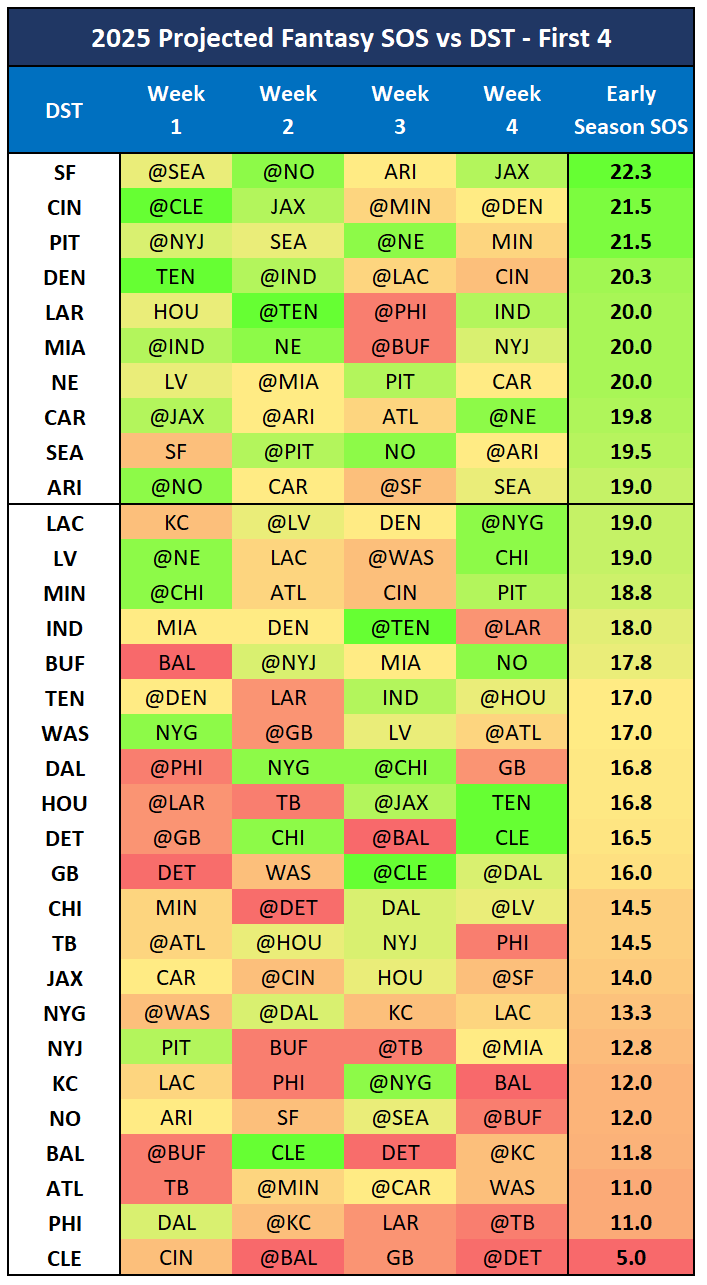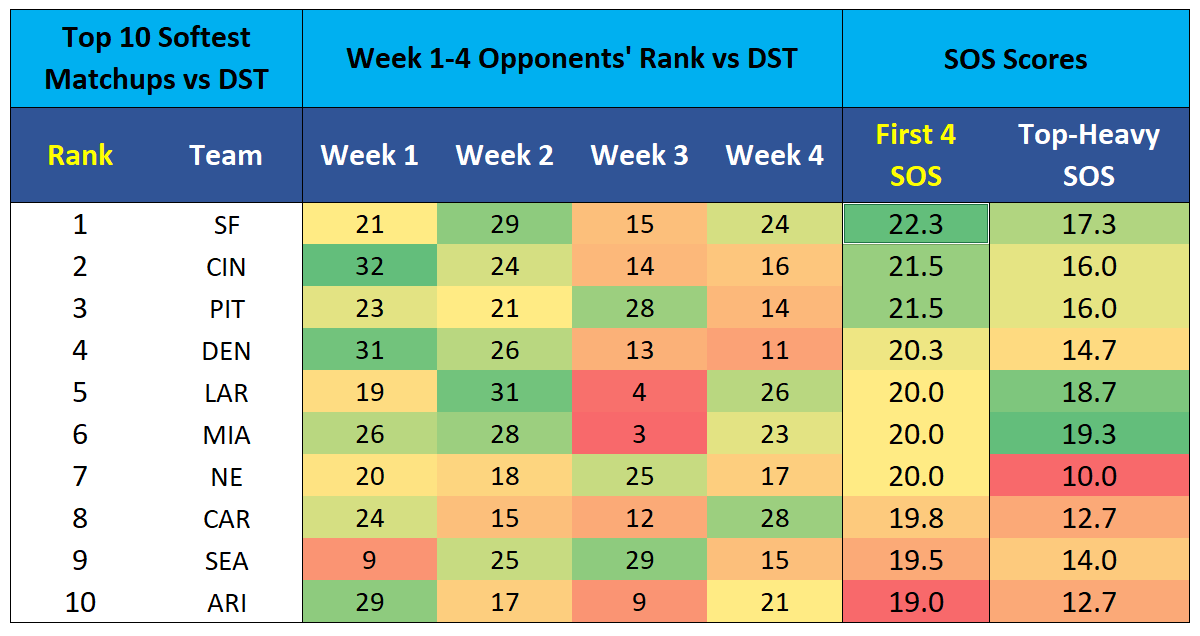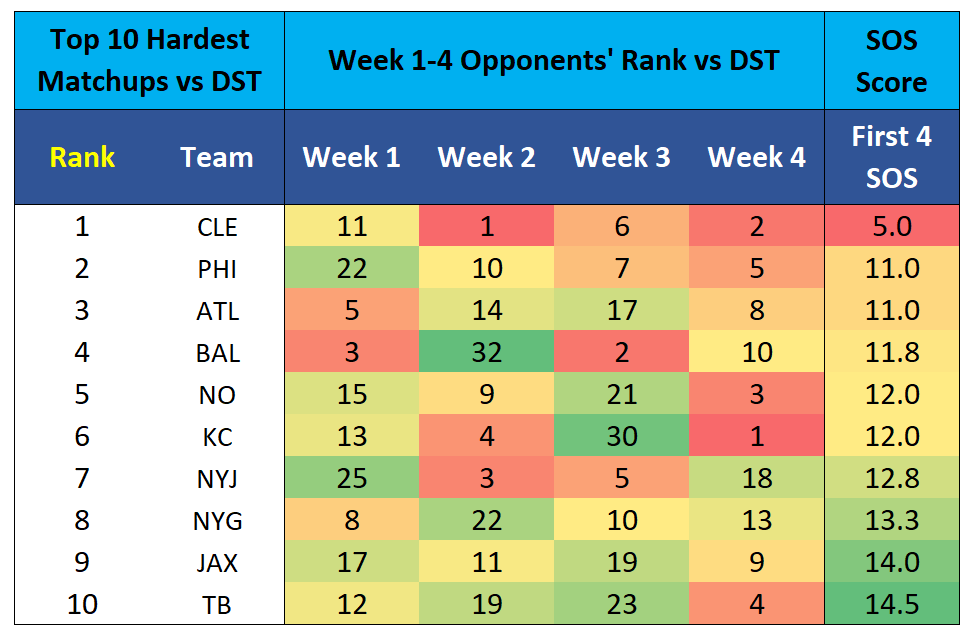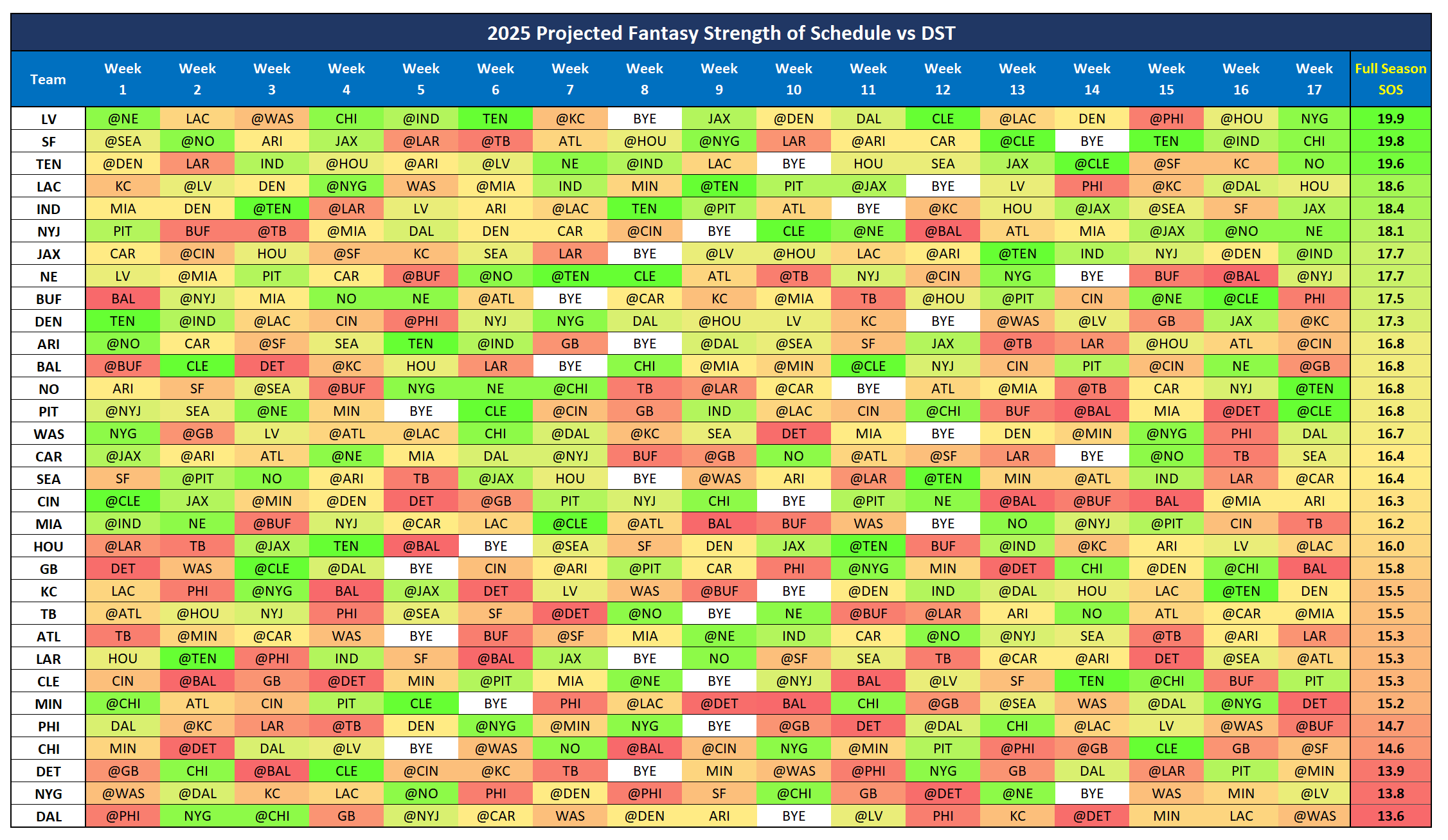Scott looks at 2025 fantasy football strength of schedules and the best D/ST matchups for the early season. Target these fantasy football team defenses in 2025 drafts.
The summer has flown by once again, and the 2025 NFL season is upon us. For some, all drafts are complete, and we anxiously await the opening kickoff. For many others, there are some last remaining drafts between now and the start of the season. We are on the brink of the annual transition from draft season to the actual fantasy football season, and this article looks at an area that spans both: fantasy strength of schedule.
Many in the fantasy football space have spent all off-season preparing (and more importantly striving to prepare you) for your drafts, and many of the same people (including myself) will continue to aspire to help you during the fantasy season. This fantasy strength of schedule article aims to do just that, and now we take a closer look at a fantasy skill position I spend much of my analysis effort on: Defense/Special Teams (D/ST).
Which top-tier defensive units also have a fantasy-friendly schedule? Should you spend relatively high draft capital on a D/ST projected to be elite? Or should you approach your draft with Week 1 in mind, waiting on D/ST until the last few rounds, and drafting a unit with a great start to the season? I am firmly on one side of this decision, as you will see in this article.
Be sure to check all of our fantasy football rankings for 2025:- 2025 fantasy football rankings
- Running back (RB) rankings
- Wide receiver (WR) rankings
- Quarterback (QB) rankings
- Tight end (TE) rankings
- Defense (D/ST) rankings
- Kicker (K) rankings
- FLEX rankings
- Dynasty rankings
Projected Strength of Schedule (SOS) Process
In this article, I will present my projected strength of schedule for the fantasy D/ST position, with a focus on the early part of the season (Weeks 1-4).
A D/ST's strength of schedule should not be the sole reason you choose to draft or not draft that unit. But it should be a piece of the puzzle. It can be a good tiebreaker. If you are on the fence about drafting a top-tier D/ST, a brutal opening schedule should at least be factored into your decision.
By projecting matchup difficulties now and also breaking the season down into different time frames (e.g., early, middle, late, and fantasy playoffs), it also allows you to strategize for D/ST "streaming," where you string together lesser-rostered D/ST's based on matchup strength. This also allows you to spend that pick where your league mates start drafting the top defenses on a much more sound investment at the skill positions.
We’ll start by examining my season-long projections, which include insight into my process and the data I use to project the strength of schedule. Then we’ll look closer at early-season SOS (top 10 easiest and top 10 hardest in Weeks 1-4). Unlike my SOS articles covering RB, QB, and TE, I will not be looking at middle-season SOS (Weeks 5-9) for fantasy D/ST in this article.
During the season, I compile game log data for every game to arrive at raw fantasy points allowed to each position each week. The goal is to have the results available before waivers, so matchup strength can be factored into those decisions.
Fantasy points allowed data can be found across the fantasy football industry. Even so, fantasy matchups are something I’ve spent a lot of time on over the last four years. I choose to do it myself so I can rearrange and reorganize in ways I think are helpful. Raw points allowed are a good starting point. But, as with most "total numbers" statistics, important context can be invisible when you stop at raw fantasy points allowed.
I take the numbers beneath the surface and bring in opponents' averages for comparison.
For example, if Team A gives up 14 fantasy points to the Eagles DST and Team B gives up the same number of points to the Jaguars DST, raw fantasy points allowed would show Team A and Team B being the same matchup difficulty against DSTs. Using “Points Over [Opponent] Average (POA)” shows a more realistic picture of strength (and weakness).
Let’s say the Eagles' DST has averaged 15 points per game and the Jaguars' DST has averaged 5 points per game. Using POA, Team A held the Eagles' DST one point under their average (a POA of -1) while Team B allowed the Jaguars' DST to score nine points above their average (a POA of +9).
From the POA angle, it is clear that these two teams should not be considered the same in terms of matchup difficulty. Raw fantasy points allowed become “opponent-adjusted” fantasy points allowed by using POA.
After the first month of the season, a team’s season-long average points allowed can look different than over a more recent stretch of games. Offenses and defenses improve or regress for various reasons. Players get injured or return from injury, coaches adjust their schemes and game plans (on both sides of the ball), and, more qualitatively, players and teams “figure it out.”
Neither season-long nor recent data sets are definitive, but it’s essential to look at both when trying to increase the probability of making the right future decisions.
These are the two existing data sets in my process for preseason projections of fantasy strength of schedule:
- Previous season POA rank (season-long).
- Previous season POA over the team’s last five games (excluding Week 18).
Stopping there doesn’t account for the impact of changes made during the off-season. If we could use previous season results to predict what will happen in the next season, fantasy football would be a lot easier (and less fun). For the future prediction piece of the process, I use Pro Football Focus (PFF) grades for team defensive lines, linebackers, and secondaries, as well as overall team offensive unit grades (for DST).
These grades are added to the equation in the following way:
- Versus QB: Defensive line and secondary grades.
- Versus RB: Defensive line and linebacker grades.
- Versus WRs: Secondary grades.
- Versus TE: Linebacker and secondary grades.
- Versus DST: Overall team offense unit grades and starting QB rank.
2025 Season-Long Fantasy SOS
I generated tables showing each team’s full-season schedule, with each weekly opponent color-coded based on that opponent’s projected rank (1-32) versus the fantasy DST position. Lower numbers, ranked in red, indicate more challenging fantasy matchups. Higher numbers ranked in green color represent easier matchups. Also known as schedule “heat maps,” the full season schedule for DSTs is included at the end of the article.
Also included are each team’s season-long SOS, which is the average of their opponents’ ranks in Weeks 1-17.
As described above, the projected ranks are based on:
- 2024 POA season-long rank
- 2024 POA rank over the team’s last five games (Weeks 13-17)
- 2025 PFF grade: Rushing unit
- 2025 PFF grade: Pass-catching unit
- 2025 PFF grade: Offensive line unit
- 2025 Starting QB Rank (non-fantasy)
Softest Early Season Schedules – Process
In separating the full season into “early, middle, and late” time frames, I define each as follows:
- Early Season: Week 1-4
- Middle-Season: Weeks 5-9
- Late Season: Weeks 10-14
- Fantasy Playoffs: Weeks 15-17
In this article, I will be looking at the Early Season schedules and the teams with the Top 10 easiest and Top 10 most challenging fantasy matchups for D/STs.
My process for determining the Top 10 easiest Early Season schedules for each D/ST is the same as season-long. I calculate the average ranks of opponents for each team in Weeks 1-4, and the 10 highest averages comprise the Top 10.
When I first wrote this article during the 2023 off-season, I introduced what I call “Top-Heavy” schedules. Some of the “easy schedules” that are initially determined by average projected rank tend to include an additional top-heavy characteristic:
Top-Heavy schedule:
A mixture of bottom-ranked opponents with one Top 10 matchup. This could also be referred to as “Extreme Matchups.” In this scenario, there is typically one brutal matchup, but outside of that, the probability of ceiling games for your fantasy players on those teams is higher. I developed a formula for determining Top-Heavy schedules.
I remove each team’s most difficult matchup from the average rank. I then averaged the remaining three ranks. From there, I added the difference between 32 (the easiest rank) and the new average of the team’s three easiest ranks. This is then filtered from highest to lowest to show the Top-Heavy SOS score and rank.
The purpose here is to remove the impact of the one difficult matchup on the overall average while also accounting for the ease of the easier matchups. The bigger the difference between 32 and the average of the team’s easiest three matchups, the lower the score, because that difference is being subtracted.
The reason I chose to examine this particular breakdown was to determine if there is a significant deviation from the score obtained by simply averaging the ranks of the first four opponents. I know we cannot merely ignore difficult matchups, but I would rather take my potential lumps with one brutal matchup if it means the chances are higher that the other three opponents could be week-winning matchups.
Soft Early Season Schedules – Defense/Special Teams (DST)
The following chart shows the teams with the top 10 easiest early-season schedules for DST, along with the rest of the teams from 11 to 32:
The following chart shows each team’s matchup rank (color-coded) in Weeks 1 through 4, followed by the average rank and Top-Heavy score.
I am a big fan of streaming DSTs. I get a lot of enjoyment out of looking ahead at matchups and picking up DSTs preemptively (if my roster construction allows it). I eagerly watch as some of my league mates reach and spend relatively high draft capital on the best NFL defenses in the 12th round, such as the Eagles or Ravens, while I scoop up depth or lottery tickets at the WR and RB positions.
My standard strategy is to then select a DST with a great Week 1 matchup in the last few rounds. This year, the target for me is the Commanders, with a Week 1 home game versus the 30th-ranked Giants. There are multiple solid Week 1 options to kick off the 2025 season. The Bengals' defense is easily their weakness this season, but they start the season with the best DST matchup against the Cleveland Browns.
The Dolphins get the 26th-ranked, Daniel Jones-led Colts in Week 1, and the Cardinals face the Saints (29th), arguably the worst offense with Spencer Rattler at the helm.
This also may be a season where I slightly break my own rule. There are a few top-level defenses that would be tempted to take a round or two earlier than the last two rounds of my draft. The Broncos are a top-level defense in 2025 and start the season at home versus the 31st-ranked Titans, which is about as rough a debut environment as possible for Titans' rookie QB, Cam Ward.
The Broncos then get the aforementioned Colts in Week 2. Denver's schedule tightens up in Weeks 3-5 against the Chargers (13th), Bengals (11th), and Eagles (4th). However, it opens up again in Week 6 against the Jets (23rd) and Week 7 against the Giants (30th).
The other upper-level defense I would consider a little earlier is San Francisco, as the 49ers check in with the most manageable Early Season schedule and the second-easiest season-long SOS. Only the Raiders' season-long DST schedule is friendlier.
The 49ers have only three Top-10 most formidable opponents, and outside of those three matchups, 11 of their 13 opponents are outside of the Top 15. So much will change between now and the fantasy playoffs, but as of now, the 49ers DST also has a highly favorable schedule in Weeks 15-17, against the Titans, Bears, and Colts.
The two units that stand out from a Top-Heavy SOS standpoint are the Rams and Dolphins. Both teams have a Top-5 matchup in Week 3 that I would stay far away from. But each team has favorable matchups in Weeks 1, 2, and 4. I prefer the Dolphins in Week 1 against the Colts (26th) and the Rams matchup with the Texans (19th). But the Rams are a great Week 2 option against the Titans and again in Week 4 versus the Colts.
Here are the Top 10 most demanding Early Season schedules for DST.
The Ravens are a tricky option to start the season with a brutal road matchup in Buffalo (third) in Week 1, followed by an early Christmas in Week 2 against the Browns. Week 3 sees their opponent strength turn sharply in the opposite direction in a matchup against the Lions (second), and Week 4 is the 10th-ranked Chiefs.
The Ravens don't see another juicy DST matchup until the Bears (27th) after their Week 7 bye. I will avoid the Ravens DST at their relatively high draft cost in all my drafts. The Browns do not have much going for them in 2025 other than a still-solid defense. However, the Cleveland DST should be nowhere near your roster, as it has one of the worst DST schedules over the first month I've seen.
The Eagles, like the Ravens, are another elite defense and the first DST I see going off the boards in the drafts I have completed. Also like the Ravens, the Eagles do have one decent matchup in the first month, Week 1 against the Cowboys (22nd). But they follow the opening weekend with three straight touch matchups versus the Chiefs (10th), Rams (seventh), and Buccaneers (fifth).
I could look silly with this call as the Eagles DST may prove to be matchup-proof, but I am not willing to pay the draft capital it takes to acquire the Eagles DST with that opening schedule. Even if they put up solid fantasy days in those touch matchups, it likely won't be drastically different than other DST options with better matchups, and I need a reasonable probability of a drastic DST advantage to pay up for the position.
2025 Strength of Schedule vs. D/ST
Before I go, I will leave you with the full-season heat map schedules for each team across each fantasy skill position. Good luck in your upcoming drafts and have a great fantasy season in 2025!
Thank you so much for reading! I love diving deep into the fantasy strength of schedule with the hope that I can help you make the best decisions possible in the maze of fantasy football decisions. I will not be writing the weekly DST article for RotoBaller again this year, but other great RotoBaller writers are continuing the series -- be sure to check out all the weekly DST articles from the awesome team at RotoBaller including our Week 1 defense streamers and starts. I will continue to compile the data and remain available to help out.
If you have any questions about this article or general questions about fantasy football, reach out to us on X (@RotoBaller).
More Fantasy Football Analysis
Download Our Free News & Alerts Mobile App
Like what you see? Download our updated fantasy football app for iPhone and Android with 24x7 player news, injury alerts, rankings, starts/sits & more. All free!






 RADIO
RADIO




























